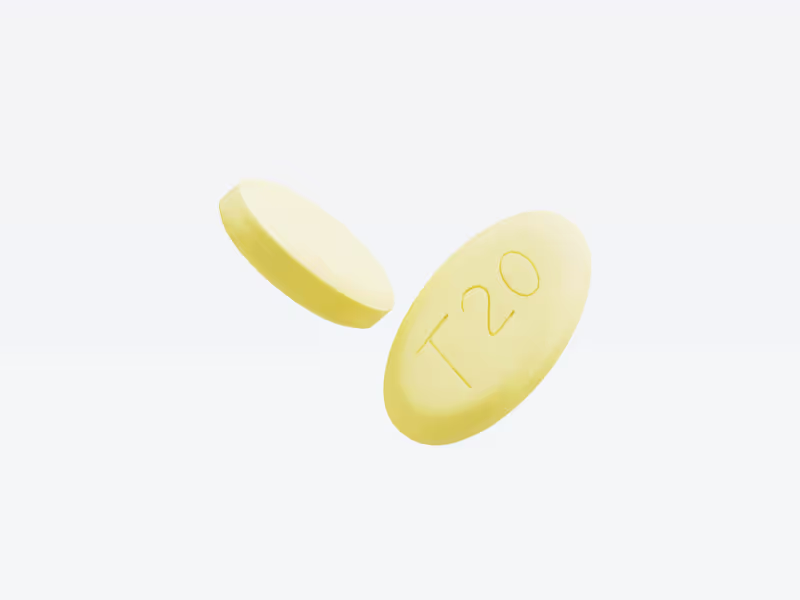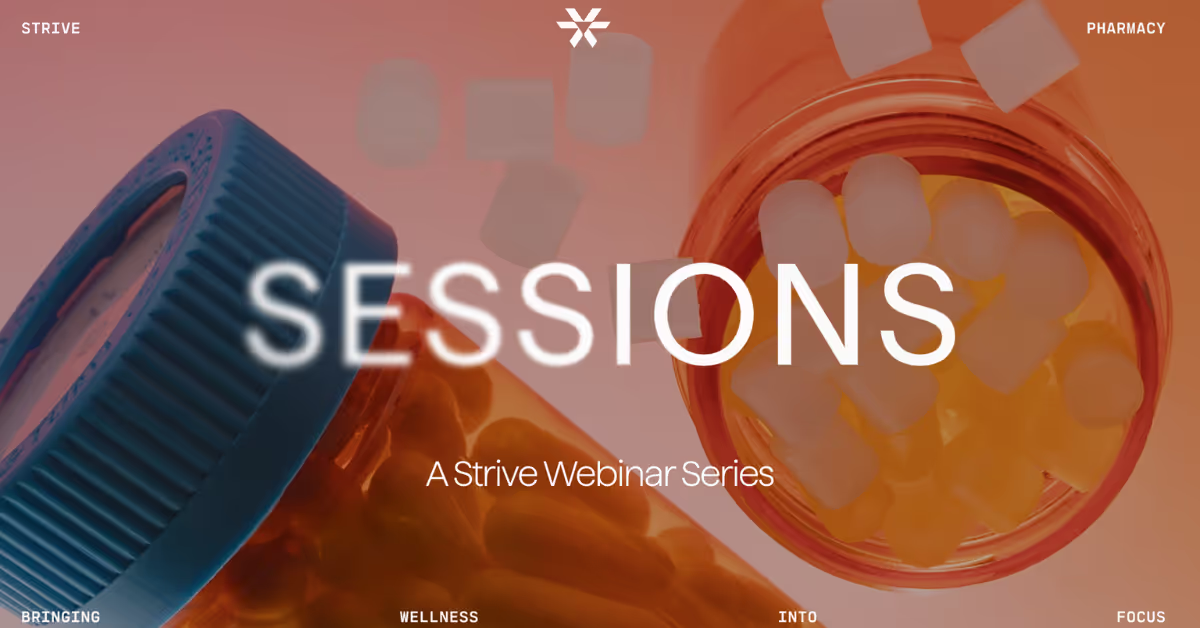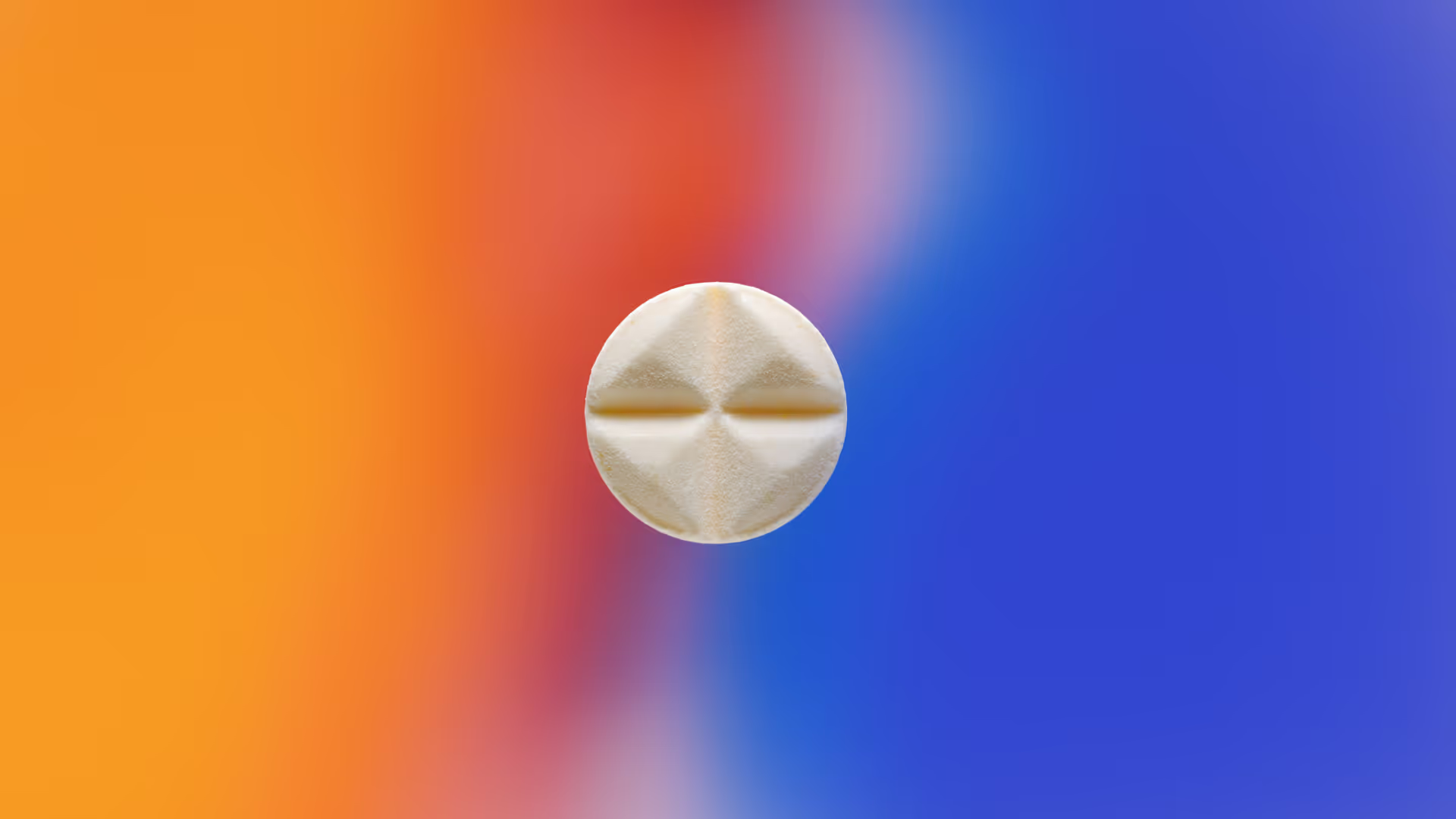Need to Knows
- Tadalafil extends beyond ED (erectile dysfunction), supporting sexual wellness, urinary function (BPH/LUTS), and pulmonary health. Ongoing research is exploring additional areas of potential benefit, including cardiovascular and neuroprotective benefits.7,8
- Flexible dosing includes 5 mg daily for steady readiness or 20 mg on-demand (up to 36 hours), with flex-dose tablet splitting for personalization.10
- Compounded advantages–such as quick-dissolve, mango-flavored sublingual tablets–may improve onset, adherence, and patient experience.
- Appropriate use requires strict avoidance with concomitant nitrate use, caution in cardiovascular/hepatic/renal disease/Hereditary degenerative retinal disorders/Pulmonary Veno-Occlusive Disease (PVOD), and patient counseling on unwanted effects and priapism.
Why Tadalafil Is More Than Just a Weekend Pill
When most people think of tadalafil, they think of erectile dysfunction (ED). But tadalafil is much more than a weekend pill. It’s a versatile, patient-friendly tool that may benefit sexual wellness, urinary health, and even pulmonary care. Providers are increasingly considering tadalafil not just as a drug for performance, but as a medication that can contribute to whole-patient wellness—daily confidence, improved urinary function, and, in certain contexts, pulmonary support.
In this article, we’ll unpack tadalafil’s dosing strategies, unique formulation opportunities, suitability profile, and counseling pearls. We’ll also discuss the emerging—but not yet established—evidence suggesting potential cardioprotective and neuroprotective roles for PDE5 inhibitors, which may reframe tadalafil as part of a more expansive approach to patient health.

Tadalafil in Clinical Practice: Rethinking Its Role Beyond Erectile Dysfunction
Most people think of tadalafil only in relation to sexual health. But that’s just a snapshot of the story. Tadalafil also plays a role in other indications—and ongoing research continues to explore potential future applications.
Potential Benefits
- Sexual wellness (ED) – Supports readiness and confidence, with flexible options for both on-demand and sustained, long-term support.
- Urinary function (BPH/LUTS) – Daily dosing has been shown to improve lower urinary tract symptoms and quality of life for men managing both ED and BPH (benign prostatic hyperplasia).¹
- Pulmonary arterial hypertension (PAH) – Benefit has been observed, although less prevalent in outpatient compounding settings.²
- Exercise training support and muscle recovery (emerging evidence) – PDE5 inhibitors are under exploration in preclinical and early clinical research.³
By positioning tadalafil as more than a one-off pill, providers can optimize sexual wellness, reduce stigma, and open new doors for patient adherence and health outcomes.
Tadalafil Dosing: Matching the Medication to the Moment
The key to tadalafil’s flexibility lies in its dual dosing strategy.
Tadalafil 5 mg Orally Once Daily
- Achieves steady-state readiness.
- Supports improvement of urinary symptoms in BPH/LUTS.1
- Offers consistent support for patients with ED who value spontaneity over planning.
Tadalafil 20 mg Orally On-Demand
- Taken by ~30 minutes before sexual activity.
- Long half-life: efficacy lasting up to 36 hours (“the weekend pill”).10
- Well-suited for patients preferring less frequent dosing.
Flex-Dose Oral Tablet Splitting
- Tablets can be split into quarters for 5 mg titration increments.
- Allows fine-tuning based on patient tolerance and outcomes.
- Personalizes care, empowering providers to adjust while staying within suitable parameters.
Critical Dosing Note
- Never exceed 20 mg of tadalafil in a 24-hour period.
- For patients using tadalafil for PAH, the recommended dose is 40 mg daily.2,10
- For patients using tadalafil for PAH, the recommended dose is 40 mg daily.2,10
- Patients should be counseled carefully on max daily dosing to avoid adverse outcomes.

Formulation Differentiator: Mango-Infused, Quick-Dissolve Tablets
Traditional tadalafil tablets work, but compounded formulations can improve both adherence and experience.
- Quick-dissolve sublingual delivery – Faster onset, bypassing some GI absorption variability.
- Mango flavor – May help reduce aversion, improve patient compliance, and lower the barrier for those hesitant to initiate the regimen..
For providers, these differentiators may lead to better adherence, fewer missed doses, and ultimately, improved outcomes.
Suitability & Contraindications: Non-Negotiables
As beneficial as tadalafil can be, caution and guardrails must always remain in place.
Absolute Contraindication
- Nitrates (e.g., nitroglycerin, isosorbide) → dangerous, potentially fatal hypotension.4
Use with Caution
- Excessive alcohol → increases dizziness, blood pressure swings.
- Cardiovascular disease → careful monitoring.
- Hepatic or renal impairment → dose adjustment often required.
- Retinal disorders → risk of sudden vision changes. Sudden vision loss in one or both eyes may be a sign of nonarteritic anterior ischemic optic neuropathy (NAION). While a direct relationship has not been established, NAION has been reported in rare cases and may result in permanent vision loss. Patients should report any sudden loss of vision immediately.
- Pulmonary veno-occlusive disease (PVOD) → avoid use.
Serious But Rare Risks
- Priapism – Requires emergency intervention if erection lasts >4 hours.
- Sudden hearing or vision loss – Counsel patients to discontinue immediately and seek evaluation.
Potential Tadalafil Side Effects Providers Should Know
- Headache, flushing, dyspepsia, nasal congestion.
- Muscle aches (notably back pain).
- Blood pressure fluctuations, nausea.
The key is setting expectations upfront. When patients understand possible side effects, they are more likely to report concerns early and use medications appropriately .

Counseling Pearls for Providers
Tadalafil can be a sensitive conversation, but providers can normalize the dialogue with the right framing.
- Set Expectations – Sexual stimulation is required; tadalafil does not create arousal on its own.
- Reinforce Suitability – Remind patients of nitrate contraindication, caution with alcohol, and warning signs of priapism.
- Individualize Care – Use flex-dosing to find the lowest beneficial dose.
- Normalize Sexual Wellness – Position ED and urinary symptoms as part of whole-patient health, not isolated or shameful issues.
This combination of clinical precision and empathetic counseling helps patients feel both supported and empowered.
Tadalafil vs Sildenafil: Key Differences Providers Should Know
Many patients ask about the difference between tadalafil and sildenafil. Here’s how to frame it:
- Duration: Tadalafil lasts up to 36 hours vs. sildenafil’s 4–6 hours.6
- Onset: Sildenafil often works slightly faster; sublingual tadalafil narrows this gap.11
- Daily Use: Tadalafil is well-suited for once-daily dosing, especially when managing both ED and BPH.10
- Tolerance: Potential side effect profiles overlap, but individual patient experience often determines preference.
Providers may find value in framing tadalafil as the “longer, steadier option” and sildenafil as the “shorter, quicker boost.” Both have their place; patient goals and lifestyle guide the choice.
Emerging Frontiers: Cardiovascular and Neurological Potential
Preclinical studies suggest PDE5 inhibitors like tadalafil are being studied for broader health outcomes.
- Cardioprotective effects – Evidence suggests possible improvements in endothelial function and reduced risk of certain cardiovascular events.7
- Neuroprotective effects –Early preclinical studies in mice suggest potential benefits in reducing inflammation and supporting cognitive function.8
- Exercise and muscle recovery – PDE5 inhibitors may decrease muscle fatigue and stimulate protein synthesis, augmenting resistance training outcomes.9
While not yet a clinical standard of care, these findings are worth watching—and may shape the future conversation around tadalafil as more than a sexual health medication.
Prescribing Tadalafil
For providers new to compounding tadalafil—or expanding patient access to daily formulations—the following steps help ensure appropriate prescribing:
- Start Low, Adjust Thoughtfully – Begin with the lowest beneficial dose, titrate with flex-splitting as needed.
- Screen Thoroughly – Always confirm no nitrate use, assess CV status, and evaluate hepatic/renal function.5
- Educate Patients Clearly – Sexual stimulation is required for tadalafil to work, possible side effects, and when to seek help.
- Consider Lifestyle Fit – Daily vs. on-demand is less about efficacy and more about patient preference.
- Leverage Compounded Advantages – Sublingual, flavored formulations improve adherence and patient experience.
Final Thoughts on Tadalafil in Whole-Patient Care
It’s time to reframe tadalafil as more than just an ED drug. For many patients, it represents freedom from rigid scheduling, relief from urinary symptoms, and improved confidence in daily life.5 For providers, it’s an opportunity to normalize sexual wellness, integrate urinary and pulmonary health into the conversation, and explore emerging cardiometabolic frontiers.
When prescribed thoughtfully—with clear guardrails and patient-centered counseling—tadalafil becomes a flexible, powerful ally in whole-patient care.
At Strive, we believe compounding isn’t about covering up symptoms; it’s about building something customized for patients who deserve more than short-term fixes and “one-size-fits-all” solutions.
Disclaimers:
The information provided in this blog article is for informational and educational purposes only. Refer to the cited references for more information regarding the content presented. The information in this blog article is not intended as a substitute for professional medical advice, diagnosis, or treatment. Never disregard professional medical advice or delay seeking medical attention because of something you have read in this blog article. The creators of this content disclaim any liability for decisions made based on the information presented.
Consult your healthcare provider before starting any over-the-counter (OTC) products or prescription medications. Always seek the advice of your healthcare provider for any questions you may have regarding a medical condition. Certain medications may interact with your current prescription medications, medical conditions, or other supplements. Your healthcare provider can provide guidance tailored to your specific health needs.
Compounded medications are specially prepared for individual patient needs and, as such, have not been reviewed or approved by the U.S. Food and Drug Administration (FDA). These statements have not been evaluated by the FDA.
References
- Brock G, Broderick G, Roehrborn CG, Xu L, Wong D, Viktrup L. Tadalafil once daily in the treatment of lower urinary tract symptoms suggestive of benign prostatic hyperplasia in men without erectile dysfunction. BJU Int. 2013;112(7):990-997. doi:10.1111/bju.12251
- Arif SA, Poon H. Tadalafil: a long-acting phosphodiesterase-5 inhibitor for the treatment of pulmonary arterial hypertension. Clin Ther. 2011;33(8):993-1004. doi:10.1016/j.clinthera.2011.06.008.
- Nelson MD, Rader F, Tang X, et al. PDE5 inhibition alleviates functional muscle ischemia in boys with Duchenne muscular dystrophy. Neurology. 2014;82(23):2085-2091. doi:10.1212/WNL.0000000000000498.
- Kloner RA, Hutter AM, Emmick JT, Mitchell MI, Denne J, Jackson G. Time course of the interaction between tadalafil and nitrates. J Am Coll Cardiol. 2003;42(10):1855-1860. doi:10.1016/j.jacc.2003.09.023.
- Fahmy G, Hess J. Tadalafil. In: StatPearls [Internet]. Treasure Island, FL: StatPearls Publishing; 2025 Jan–. Updated March 20, 2024.
- Taylor J, Baldo OB, Storey A, Cartledge J, Eardley I. Differences in side-effect duration and related bother levels between phosphodiesterase type 5 inhibitors. BJU Int. 2009;103(10):1392-1395. doi:10.1111/j.1464-410X.2008.08328.x.
- Kloner RA, Stanek E, Desai K, et al. The association of tadalafil exposure with lower rates of major adverse cardiovascular events and mortality in a general population of men with erectile dysfunction. Clin Cardiol. 2024;47(2):e24234. doi:10.1002/clc.24234.
- Gulati P, Singh N. Neuroprotective effect of tadalafil, a PDE-5 inhibitor, and its modulation by L-NAME in a mouse model of ischemia-reperfusion injury. J Surg Res. 2014;186(1):475-483. doi:10.1016/j.jss.2013.08.005.
- Duranti G, Ceci R, Sgrò P, Sabatini S, Di Luigi L. Influence of the PDE5 inhibitor tadalafil on redox status and antioxidant defense system in C2C12 skeletal muscle cells. Cell Stress Chaperones. 2017;22(3):389-396. doi:10.1007/s12192-017-0778-9. PMID: 28283895; PMCID: PMC5425369.
- UpToDate Lexi-Drugs. Tadalafil: Drug Information. In: LexiComp Online. Wolters Kluwer Health; 2025.
- Wright PJ. Comparison of phosphodiesterase type 5 inhibitors. Int J Clin Pract. 2006;60(8):967-975. doi:10.1111/j.1742-1241.2006.01049.x. Epub 2006 Jun 16. Erratum in: Int J Clin Pract. 2006;60(11):1517. PMID: 16780568.
















